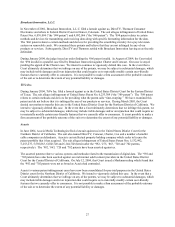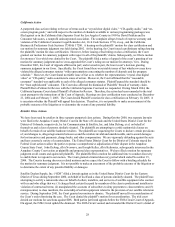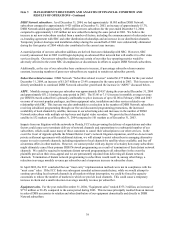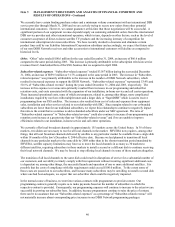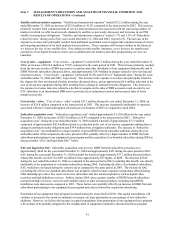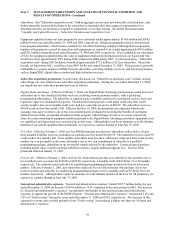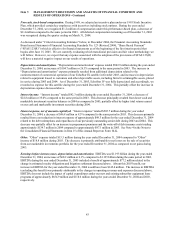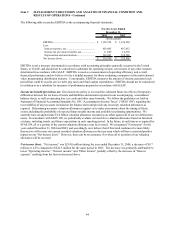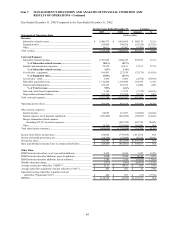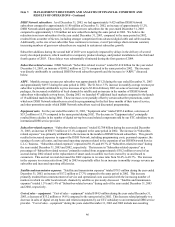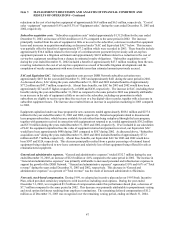Dish Network 2004 Annual Report Download - page 45
Download and view the complete annual report
Please find page 45 of the 2004 Dish Network annual report below. You can navigate through the pages in the report by either clicking on the pages listed below, or by using the keyword search tool below to find specific information within the annual report.Item 7. MANAGEMENT’S DISCUSSION AND ANALYSIS OF FINANCIAL CONDITION AND
RESULTS OF OPERATIONS - Continued
37
General and administrative expenses. “General and administrative expenses” primarily include employee-related
costs associated with administrative services such as legal, information systems, accounting and finance. It also
includes outside professional fees (i.e. legal and accounting services) and building maintenance expense and other
items associated with administration.
Interest expense. “Interest expense” primarily includes interest expense, prepayment premiums and amortization of
debt issuance costs associated with our debt and convertible debt securities, net of capitalized interest.
Other. The main components of “Other” income and expense are equity in earnings and losses of our affiliates,
gains and losses on the sale of investments, and impairment of marketable and non-marketable investment securities.
Earnings before interest, taxes, depreciation and amortization (“EBITDA”). EBITDA is defined as “Net income
(loss)” plus “Interest expense” net of “Interest income,” “Taxes” and “Depreciation and amortization.”
DISH Network subscribers. We include customers obtained through direct sales, and through our retail networks,
including our co-branding relationship with SBC and other distribution relationships, in our DISH Network subscriber
count. We believe our overall economic return for co-branded and traditional subscribers will be comparable. We also
provide DISH Network service to hotels, motels and other commercial accounts. For certain of these commercial
accounts, we divide our total revenue for these commercial accounts by an amount approximately equal to the retail
price of our most widely distributed programming package, AT60 (but taking into account, periodically, price changes
and other factors), and include the resulting number, which is substantially smaller than the actual number of
commercial units served, in our DISH Network subscriber count.
During April 2004, we acquired the C-band subscription television service business of SNG, the assets of which
primarily consist of acquired customer relationships. Although we expect to convert some of these customer
relationships from C-band subscription television services to our DISH Network DBS subscription television service,
acquired C-band subscribers are not included in our DISH network subscriber count unless they have also subscribed to
our DISH Network DBS television service.
Monthly average revenue per subscriber (“ARPU”). We are not aware of any uniform standards for calculating
ARPU and believe presentations of ARPU may not be calculated consistently by other companies in the same or
similar businesses. We calculate average monthly revenue per subscriber, or ARPU, by dividing average monthly
“Subscriber-related revenues” for the period (total “Subscriber-related revenues” during the period divided by the
number of months in the period) by our average DISH Network subscribers for the period. Average DISH Network
subscribers are calculated for the period by adding the average DISH Network subscribers for each month and
dividing by the number of months in the period. Average DISH Network subscribers for each month are calculated
by adding the beginning and ending DISH Network subscribers for the month and dividing by two. As discussed in
“Subscriber-related revenue” above, effective January 1, 2004 we include amounts previously reported as “Other
subscriber-related revenue” in our ARPU calculation. All prior period amounts conform to the current period
presentation.
Subscriber churn/subscriber turnover. We are not aware of any uniform standards for calculating subscriber churn
and believe presentations of subscriber churn may not be calculated consistently by different companies in the same
or similar businesses. We calculate percentage monthly subscriber churn by dividing the number of DISH Network
subscribers who terminate service during each month by total DISH Network subscribers as of the beginning of that
month. We calculate average subscriber churn for any period by dividing the number of DISH Network subscribers
who terminated service during that period by the average number of DISH Network subscribers eligible to churn
during the period, and further dividing by the number of months in the period. Average DISH Network subscribers
eligible to churn during the period are calculated by adding the DISH Network subscribers as of the beginning of
each month in the period and dividing by the total number of months in the period.
Free cash flow. We define free cash flow as “Net cash flows from operating activities” less “Purchases of property
and equipment,” as shown on our Consolidated Statements of Cash Flows.


